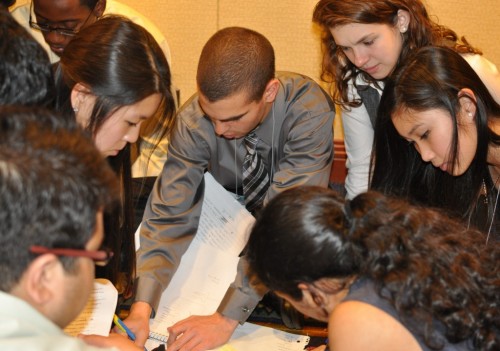Often one of the most grueling processes in a Model UN conference, a merge tests even the finest of delegates, as they are immersed in a situation where negotiation skills must be laced with means of diplomacy in order to achieve a cohesive final product. As Model UN delegates, it is imperative that we honor the ideals of compromise and collaboration in committee, and there’s no better way to demonstrate the importance of collaboration than by engaging in a merge.
The first order of business in conducting a merger is as follows: be cognizant of the views of respective papers, and ensure that there are no differing policies between two papers that are involved in a merger. At times, questionable merges occur, and the final product becomes convoluted and is open to attack from members of committee, given the major differences in the pre-merge papers. Once you’re aware of the different qualities and characteristics of opposing documents, feel free to approach blocs which are formulated with similar policies and ideas. It is highly imperative that you collaborate with smaller and less represented papers (which are a significant portion), which usually results in widespread support from smaller coalitions, therefore ensuring that the solutions which you have presented to committee have a much better chance of being heard by the committee. In a General Assembly or an EcoSoc, committee support is crucial to increase the chance of passing any written work that you have posited—by merging with papers which are fighting for a voice, you are considerably increasing not only the size of your coalition, but the influence that it holds in committee.
Now, after you complete the smaller merges, alert the chair. However, go about this process in a casual manner, for example:
“Hey, I’m sorry to bother you, I just wanted to let you know that [your country] has merged with [country A], [country B], and [country C].” The chair will now know that you’re highly integral in the merging process, which as you know is a significant aspect at conferences. When initiating a merge, bring along several allies with you—it is best if your paper is more represented during the merge, compared to the other paper. That way, you have delegates supporting your decisions. At times, delegates insist on using their particular USB or their laptop—there is a certain way to get around this:
Sample Situation – The other delegate is being very adamant on using his laptop:
“Okay, that’s fine, we’ll use my USB and your laptop.” [Name your USB your country name]
When going through a merge, sit in the center of the formation. Also, try being the first one to walk out and say something along the lines of, “Thanks for coming out everyone, we’re merging the paper drafted by [your country] and [other delegate]. Feel free to join us, we’re looking for everyone’s input here. We have to get this done by 3:00, so let’s get started”
By formally introducing the merge to everyone, you sound like the leader. However, sounding like the leader and being the leader are two very different things. For you to become a leader, you must be prepared to keep in mind the interests of all nations present in the merging process. While great delegates lead, the best delegates listen and mediate. The following is advantageous when conducting a merger:
- Highlight the clauses of the other paper which you wish to retain. If any commonalities exist clauses from the two papers, find a way to either expand the pre-existing clause.
- Strike the clauses of the other paper which do not quite match the vision that you have set for the future paper.
- Create a list which underscores any concerns that opposing blocs have about both papers. It is very likely that their concerns may be legitimate, and to incorporate any new clauses addressing their qualms would make you appear diplomatic and reasonable. Remember– each nation is looking to have their voice heard, whether they’re from your bloc or not, find a way to include their thoughts into your paper.
- Coordinate with fellow authors of your paper in developing a strategy of the merge to solidify your approach.
- Abide by the 3 C’s: Be Calm, Confident, Chill. If other delegates begin to raise their voices and present a more aggressive approach to the issue– maintain a collected demeanor to show that you’re able to respond to a high-pressure situation.
At the same time, don’t be afraid to be assertive when need be—at the end of the day, you want your paper to heavily influence the final product. Obviously be diplomatic, but don’t be afraid to have the final word. It helps if your paper is longer, as it can be the skeleton of the future resolution. The support which you have garnered will back you up on a majority of any clauses that you want to include. If you do not wish to go through a war of words and verbal repartees, it is suggested that you simply add a majority of clauses from the other paper into your paper, to ensure that the merge is painless and that all parties are content with the end result.



